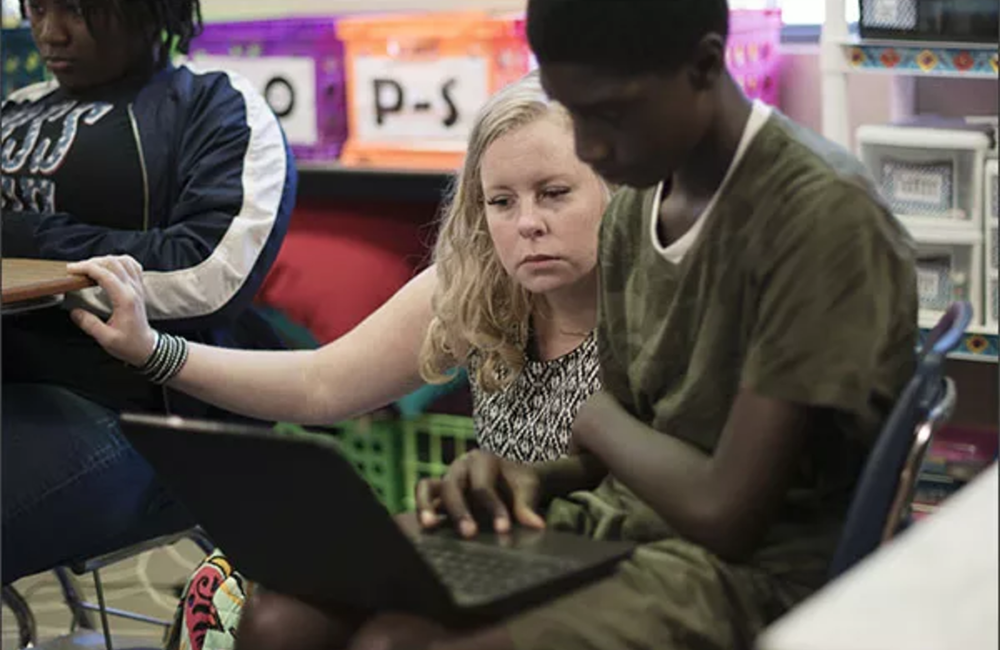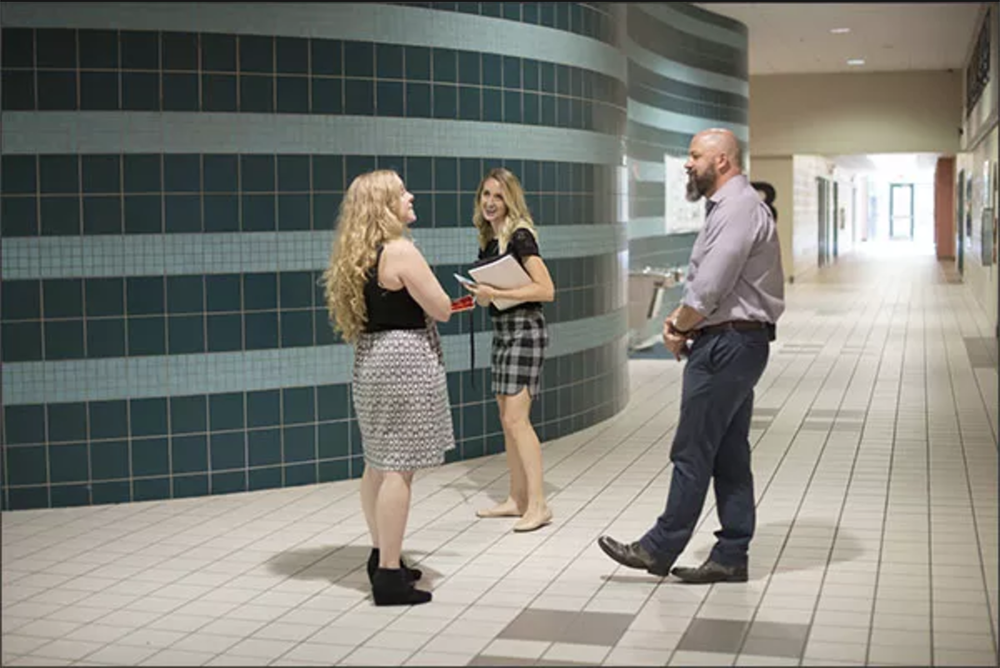To Improve Teachers' Use of Technology, Schools Try Hiring Coaches

Technology coach Danielle Johnson assists a student with his computer during her daily
rounds on campus at Barbara Bush Middle School in Irving, Texas.
—Brandon Thibodeaux for Education Week
KENNESAW, Ga. (Oct 5, 2018) — A week before school started, Danielle Johnson was already in midyear form, revving up the staff here at Barbara Bush Middle School by praising their “risk-taking swag” and assuring them they’re on the front lines of closing the new digital divide in America’s classrooms.
“Technology isn’t going to save education,” Johnson told her colleagues during their first in-service day of the new year. “It isn’t about what you have in your hands but what you do with it that makes an impact on our students.”
That could be the mantra of the Dynamic Learning Project, a $6.5 million, Google-funded initiative to improve technology coaching in K-12 schools in a handful of states around the country. The project aims to get classrooms using technology for “powerful” learning activities, such as collaboration and critical thinking.
Johnson is one of the 50 teachers-turned-coaches who kicked the project off last school year. Now, the work she helped lead at Bush Middle is being touted as a model.
The keys to the school’s early success: a focus on relationships; supportive leadership; a common vision, in which adults relinquish some control over their classrooms and give students more room to explore and create with digital tools; and a recognition that every educator will need to take his or her own path to reach that end goal.
“Barbara Bush Middle School has used [technology] coaching to build a positive, collaborative, and growth-oriented culture amongst teachers,” said Karen Cator, the CEO of Digital Promise, the pro-school technology nonprofit organization that is administering the Dynamic Learning Project. “Other school leaders and coaches can certainly learn from their example.”
Building on Strong Relationships
In general, instructional coaching as a strategy for helping teachers is backed by a wealth of academic research.
And it’s an approach the 26,000-student Carrollton-Farmers district has long embraced to improve teaching and learning across the board.
So when the district decided last school year to give Chromebooks to the students at Bush and its other middle schools, and then the invitation came to join the Dynamic Learning Project, signing up was a no-brainer, said Matt Warnock, Bush’s principal.
“A lot of schools have devices, but many of them end up sitting there because teachers don’t know how to use them or they’re scared of them,” Warnock said. “We had the hunger to make sure we were hitting the higher-order [learning] activities.”
To help spur that along, Google paid the first-year salaries of the new coaches at all 50 schools in the project. All the coaches were former classroom teachers, and most had previously taught at the same schools.
Warnock said he tapped Johnson for two reasons: She’s tech savvy. And, more importantly, she had already built strong relationships with other staff members at Bush during her years as a 6th grade social studies teacher there.
Both factors led 7th grade social studies teacher Abbey Petersen to jump at the chance to work with Johnson last year.
“I was definitely excited about doing more innovative things,” Petersen said. “And I trusted Danielle to help because I knew how often she tries that herself.”
The pair started slow, focusing on using technology to streamline Petersen’s process for editing and grading student papers.
But by the second half of the year, they started thinking bigger. With Johnson as her sounding board and logistical aide, Petersen came up with a classroom project in which students chose a social-justice issue, formed teams, and worked to hone and broadcast their message.
With that experience under her belt, Petersen hit the ground running this August.
During the first week of school, for example, she kicked off a new project focused on the importance of identifying when people’s voices are—and are not—represented in the stories told about them.
The 7th graders in her Individuals and Societies class used their Chromebooks to respond to a common writing prompt—and to read and comment on each other’s entries. That segued into a lively class discussion, then an online poll activity in which students could see each other’s responses projected on to the whiteboard at the front of the room. That, in turn, led to more enthusiastic discussion.
With 15 minutes left in the period, Petersen gave her first big assignment of the year: Tell one of your own stories, using whatever medium you feel most comfortable in—from text to video to song.
The students dove in, popping in earbuds and starting to type in ideas about everything from annoying siblings to basketball tryouts.
After class, Petersen said she developed the project on her own, but Johnson’s voice was in the back of her head.
“I definitely think the coaching has helped me to realize that I don’t have to have all the answers,” she said. “I have no idea what these kids are going to come up with, and that’s actually a very freeing thing.”
More Typical Coaching?
That’s exactly the mindset and classroom practice that Cator of Digital Promise hopes coaching can encourage.
“We’re going after the powerful use of technology,” she said. “Things like collaboration, creativity, communication, and developing a sense of agency among teachers.”
Big picture, though, it remains uncertain how much that actually happened during the first year of the Dynamic Learning Project. According to a report released last month by Digital Promise, 86 percent of the teachers who received coaching via the initiative said they used technology more frequently than in years past. But whether such use counted as “powerful,” rather than rote or administrative, isn’t clear.

Technology coach Danielle Johnson, left, consults with Principal Matt Warnock and
teacher Abbey Petersen between classes at Barbara Bush Middle School in Irving, Texas.
—Brandon Thibodeaux for Education Week
At Bush Middle, for example, eighth-year science teacher Mandie Cooper had what seemed to be a more typical coaching experience.
Her focus: keeping her classroom organized.
With Chromebooks suddenly in the mix, that meant working with Johnson to incorporate new apps. One allowed Cooper to monitor what students were looking at on their screens. Another allowed her to better control how students interacted with the digital slide decks she taught from. A third was a popular quiz app used for standardized-test review.
And this school year started similarly. During the first week of school, Cooper walked her 8th graders through the process of setting up their own Google sites for saving notes and assignments.
Unlike the collaborative, student-directed activity Petersen facilitated, the action in Cooper’s room centered around students following her step-by-step instructions for copying headings, which were handwritten on a paper flip chart at the front of the room, into Google’s learning-management system, called Classroom.
“Literally type in the words ‘About Me,’ and then click ‘done,’ ” Cooper instructed. “Congratulations, you added a page.”
Like many schools, Bush Middle uses the SAMR (short for Substitution, Augmentation, Modification, Redefinition) framework to guide its integration of technology into the classroom. The idea is to push teachers to move beyond digital versions of paper worksheets to think about how technology can reshape what teaching and learning look like.
The kinds of powerful technology uses the Dynamic Learning Project is looking for are typically found at the M and R end of the SAMR scale.
Cooper said that’s where she hopes to get—eventually.
“I do a lot of substitution right now,” she said. “It’s definitely a work in progress.”
‘Everyone Is Moving Forward’
To make a real impact, experts say, coaching has to be grounded in teachers’ everyday lived experiences, it has to be supported by leadership and become part of the school’s mode of operations, and it has to be sustained over time.
Bush Middle appears to have a solid foundation on the first two items.
Just look at Principal Warnock’s enthusiastic reaction to Cooper’s efforts. The coaching she receives is focused on helping her keep striving toward a common vision, he said, not on evaluating her against a set standard or expectation.
“What you’re doing may look different than the person next to you,” Warnock said. “But everyone is moving forward.”
And as for sustainability?
The Carrollton-Farmers district gave the Dynamic Learning Project a strong vote of confidence at the end of last school year, deciding to not only keep the model for a second year but also to expand it to the high schools—even though Google is no longer footing the bill. The net cost will be about $130,000 this year, to be covered by repurposing some federal Title I and Title II funds.
Why make the investment?
District officials couldn’t pinpoint hard data showing that coaching had improved student-test scores. But they said they saw plenty of evidence of something they consider just as important.
Take, for example, the classroom of special education teacher DeShannon Richburg, a longtime aide at Bush who is in her first year with her own classroom and has just started receiving technology coaching.
Asked if she’s a tech person, Richburg lets out a loud laugh.
“I’m old school,” she said.
But on just her fourth day, Richburg had her students—who have learning and developmental disabilities and will spend the year learning to compose complete sentences and paragraphs—testing out their Chromebook’s special accommodations, such as a speech-to-text tool, while writing out recipes for how to make a cake.
When one of her 7th graders asked how long a cake takes to bake, Richburg started to answer.
Then a light bulb went off. Richburg stopped herself midsentence, then encouraged the boy to see if he could use a search engine to find the answer himself.
“The old me would say, ‘Oh, this is how you do it,’ ” Richburg said later.
“But my babies shouldn’t need me all the time when they have the tools and resources they need to explore.”
This special report was produced with support from the Carnegie Corporation of New York. Coverage in Education Week of learning through innovative designs for school innovation is supported in part by a grant from the Carnegie Corporation of New York at www.carnegie.org. Education Week retains sole editorial control over the content of this coverage.
Education Week
Oct 3, 2018
















